WASHING MACHINES
..........
By Lee Maxwell
 In Grandmother's estimation, if there was a
perfume called "scent of satisfaction, "its fragrance would be
that of a huge pile of just-finished laundry. Indeed it was satisfying to have
the chore of Mondays done, and to be able to sit down, have a cup
of tea and just relax for a bit. During her tenured term of doing laundry, from
about 1890 to 1950, Grandma had spanned the (Washing Machine) age, during which
a great majority of the innovation in laundry devices was made. Before the late
1800's there were relatively few factory-made laundry devices which had
multiple moving parts. Since 1950, few notable changes have occurred in the way
washing is done.
In Grandmother's estimation, if there was a
perfume called "scent of satisfaction, "its fragrance would be
that of a huge pile of just-finished laundry. Indeed it was satisfying to have
the chore of Mondays done, and to be able to sit down, have a cup
of tea and just relax for a bit. During her tenured term of doing laundry, from
about 1890 to 1950, Grandma had spanned the (Washing Machine) age, during which
a great majority of the innovation in laundry devices was made. Before the late
1800's there were relatively few factory-made laundry devices which had
multiple moving parts. Since 1950, few notable changes have occurred in the way
washing is done.
With modern plumbing we no longer have to heat the water on the old cook
stove, pour it in the washer and rinse tubs, then after the wash, haul it
outside. In rural areas, before REA electrical distribution services became
available, the farmer would usually have to stay around the house for awhile on
Monday morning to get the old kick-start, 2-cycle gasoline washing machine
engine running. Many of this older, and experienced generation can produce
evidence, in the form of scars, which attest to past dangers of using a wringer
washing machine.
Technology has taken us a fair way from the rock, used to pound the clothes
at the river bank, to the modern rectangular shaped white box with appropriate
buttons for permanent press and delicate fabrics. What would grandma have
thought if she were given the choice of "delicate" or "permanent
press"? Certainly the pair of bib-overalls that had been on granddad for
the past week, or two, would not have fit within either category. The marvelous
way of how we got from the rock to the big white box has gone almost unnoticed.
There is little literature on the subject, nor is there any comprehensive
museum display of the evolution of the washing machine. Except for Maytag,
there has been minimal corporate interest in maintaining historical archives.
The Jasper County
museum, Newton, Iowa
houses an excellent collection of Maytag washing machines along with some 20
other washers produced by local manufacturers.
Washing machines do not have the allure of other old mechanical relics such
as cars, tractors, internal combustion engines or gasoline pumps, where, for
each, there are literally hundreds of proud and enthusiastic collectors. With
rare exception, antique dealers avoid washing machines like the plague. At
least one contemporary antique columnist has claimed washing machines to be
little more than "junque". Could it be that the washing machine
is "antiquities'' ugly duckling"?
The reader will, I hope, agree that the "almost-antiseptic"
washing machines of today don't have nearly the charm nor the character, albeit
hazardous character, of those our grandmothers used. Our presentation herein is
focused on the elegant washing machines which were powered either with gasoline
engines or electric motors and were in use from 1900-1935. In 1920 there were
over 1300 companies producing washers, and it is feasible here to show only a
sampling of the myriad designs and shapes produced. Selected for illustration,
are about 5% of the machines in my "hobby museum" located in Eaton,
Colorado. Indeed, there is a lot
more to see.
Prior to 1900 most washing machines were "people powered" . There
were, however, some attempts to ease "women's work" with the use of
water, steam or animal power to drive the washing machine. With the advent of
the internal combustion engine and especially the electric motor along with
electric distribution systems, powered washing machines began to proliferate.
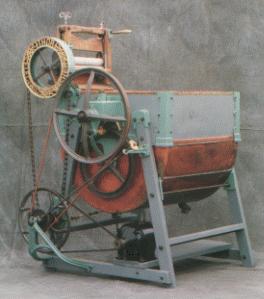 Among the
early electric powered machines to be mass produced was the Thor washer of Fig.
1. Features of this machine, made by the Hurley Machine Company of Chicago,
(ca. 1908), include a wooden drum into which the clothes are put to be tumble
washed. The drum turns 8 revolutions in one direction, then reverses. A control
on the lower left side of the machine engages the clutch to start the rotation.
A lever, on the top right side, provides forward and reverse control for the
chain driven wringer. At the time when this machine was manufactured, safety
releases for wringers were not yet perfected. And, since most electric machines
did not have on-off switches, if a finger or some other part of the anatomy
were caught in the wringer one would have to grab the electric cord and yank it
out of the outlet. Some cords had a terminal which could be screwed into a
light socket, and even with vigorous yanking you could not have easily stopped
the wringer from swallowing your entire arm. One day, I was explaining to a
group how dangerous the machines could be. A lady leaned over and shyly
demonstrated the 2-inch diameter scar on the top of her head. As a young girl,
she had been helping her mother do the laundry when the wringer caught one of
her long braids and proceeded to scalp her!
Among the
early electric powered machines to be mass produced was the Thor washer of Fig.
1. Features of this machine, made by the Hurley Machine Company of Chicago,
(ca. 1908), include a wooden drum into which the clothes are put to be tumble
washed. The drum turns 8 revolutions in one direction, then reverses. A control
on the lower left side of the machine engages the clutch to start the rotation.
A lever, on the top right side, provides forward and reverse control for the
chain driven wringer. At the time when this machine was manufactured, safety
releases for wringers were not yet perfected. And, since most electric machines
did not have on-off switches, if a finger or some other part of the anatomy
were caught in the wringer one would have to grab the electric cord and yank it
out of the outlet. Some cords had a terminal which could be screwed into a
light socket, and even with vigorous yanking you could not have easily stopped
the wringer from swallowing your entire arm. One day, I was explaining to a
group how dangerous the machines could be. A lady leaned over and shyly
demonstrated the 2-inch diameter scar on the top of her head. As a young girl,
she had been helping her mother do the laundry when the wringer caught one of
her long braids and proceeded to scalp her!
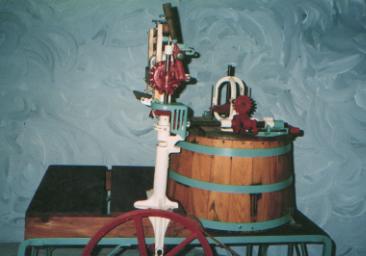 Featuring very
rudimentary gearing, the machine (maker unknown), of Fig 2., was among
the first produced to have forward and reverse action for the powered wringer.
A safety feature is provided by the lever on the lid of the tub as it
disengages the clutch, thereby stopping the agitator when the lid is opened.
Before I found it, this machine had been sitting outside behind Tom Coffee's
hardware store in Vienna, Missouri
for some 50 years. Besides being half buried, it had a tree, 8" in
diameter, growing up through its angle iron frame. I yet believe Tom had been
waiting all those years for some one like me to come along and saw down that
old unwanted tree.
Featuring very
rudimentary gearing, the machine (maker unknown), of Fig 2., was among
the first produced to have forward and reverse action for the powered wringer.
A safety feature is provided by the lever on the lid of the tub as it
disengages the clutch, thereby stopping the agitator when the lid is opened.
Before I found it, this machine had been sitting outside behind Tom Coffee's
hardware store in Vienna, Missouri
for some 50 years. Besides being half buried, it had a tree, 8" in
diameter, growing up through its angle iron frame. I yet believe Tom had been
waiting all those years for some one like me to come along and saw down that
old unwanted tree.
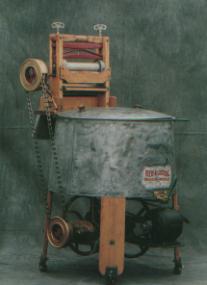 The Red
Electric, Fig. 3, is somewhat unusual, as its dolly, (or "milk
stool" or "udder") type agitator is powered via a shaft through
the bottom of the tub. Most machines of this early 1900's vintage have the
agitator powered from above, through the lid of the tub. This machine had been
used by one of the mining families of Leadville,
Colorado.
The Red
Electric, Fig. 3, is somewhat unusual, as its dolly, (or "milk
stool" or "udder") type agitator is powered via a shaft through
the bottom of the tub. Most machines of this early 1900's vintage have the
agitator powered from above, through the lid of the tub. This machine had been
used by one of the mining families of Leadville,
Colorado.
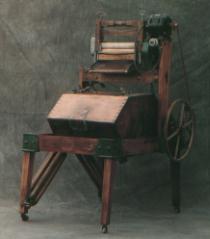 November 12, 1909
is the last patent date shown on the Judd rocker washing machine of Fig 4.
Rocker-type machines became popular in the early 1920's and over twenty
companies produced them. The Judd washer with no wringer safety release, a
number of unshielded gears and pulleys along with a top-mounted electric motor
with non-insulated terminals, and no hint of electrical grounding, would have,
at least today, surely made some consumer safety group sit up and take notice.
November 12, 1909
is the last patent date shown on the Judd rocker washing machine of Fig 4.
Rocker-type machines became popular in the early 1920's and over twenty
companies produced them. The Judd washer with no wringer safety release, a
number of unshielded gears and pulleys along with a top-mounted electric motor
with non-insulated terminals, and no hint of electrical grounding, would have,
at least today, surely made some consumer safety group sit up and take notice.
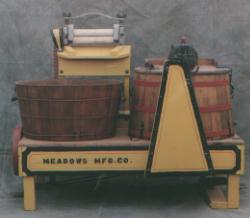 The Meadows belt driven
machine of Fig. 5, produced in Pontiac
Illinois, has been painted its
original color with the exception of the wooden tub, which had also been bright
yellow. A stationary gasoline ("hit and miss") engine would have been
used to power this machine. The washing machine along with the engine belted to
it would have been operated outdoors or in a separate wash house. Although,
some back porches were equipped with line shafts having a number of different
pulley sizes, like blacksmith shops, whereby appliances like cream separators,
butter churns as well as washing machines could be belt driven by an engine
located outside the house. A pair of foot pedals at each end of the Meadows
machine serve as forward and reverse controls for the wringer. The wringer is
mounted on a frame which slides along a track allowing the wringer to be
positioned either at the wash tub or at the rinse tub.
The Meadows belt driven
machine of Fig. 5, produced in Pontiac
Illinois, has been painted its
original color with the exception of the wooden tub, which had also been bright
yellow. A stationary gasoline ("hit and miss") engine would have been
used to power this machine. The washing machine along with the engine belted to
it would have been operated outdoors or in a separate wash house. Although,
some back porches were equipped with line shafts having a number of different
pulley sizes, like blacksmith shops, whereby appliances like cream separators,
butter churns as well as washing machines could be belt driven by an engine
located outside the house. A pair of foot pedals at each end of the Meadows
machine serve as forward and reverse controls for the wringer. The wringer is
mounted on a frame which slides along a track allowing the wringer to be
positioned either at the wash tub or at the rinse tub.
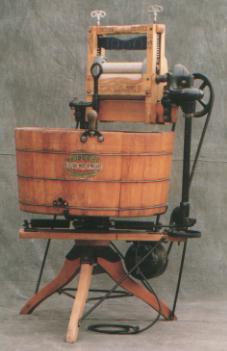 The
"electric motor washer", Fig. 6, was in the early line of
powered models manufactured by the Nineteen Hundred Corporation, This 1900
company finally evolved into the present Whirlpool Corporation. This machine
features a fixed agitator and an oscillating wooden tub. A single lever on the
wringer post serves as the sole control for this machine. In one position the
tub oscillates while in the other, the wringer turns. This is a rare example
whereby the wringer, on a powered machine, is allowed to rotate only in a
single direction. Imprinted on the side of the wringer is the phrase . What a wonderfully gallant thought!
The
"electric motor washer", Fig. 6, was in the early line of
powered models manufactured by the Nineteen Hundred Corporation, This 1900
company finally evolved into the present Whirlpool Corporation. This machine
features a fixed agitator and an oscillating wooden tub. A single lever on the
wringer post serves as the sole control for this machine. In one position the
tub oscillates while in the other, the wringer turns. This is a rare example
whereby the wringer, on a powered machine, is allowed to rotate only in a
single direction. Imprinted on the side of the wringer is the phrase . What a wonderfully gallant thought!
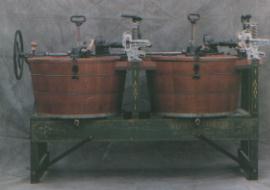 The double tub
Women's Friend machine, shown in Fig. 7, could be either electric or
gasoline powered. Double tub machines, such as this, were made to decrease the
time required to do the laundry. They were especially popular in those families
having more than several children. The drive mechanisms for the agitators are
reminiscent of the pitman rods used in hay mowers. Grease cups on the tub lids
provided lubrication for the agitator shafts. Can you imagine keeping the white
shirts white as bits of grease find there way into the wash tub?
The double tub
Women's Friend machine, shown in Fig. 7, could be either electric or
gasoline powered. Double tub machines, such as this, were made to decrease the
time required to do the laundry. They were especially popular in those families
having more than several children. The drive mechanisms for the agitators are
reminiscent of the pitman rods used in hay mowers. Grease cups on the tub lids
provided lubrication for the agitator shafts. Can you imagine keeping the white
shirts white as bits of grease find there way into the wash tub?
The Prima wooden tub rocker, Fig. 8, produced in Duluth,
Minnesota has
"Nevercrush" boldly embossed on its cast aluminum framed wringer. A
decal, on the side of the wringer, pictures fingers which are "never
crushed." A freely swinging lever, when pushed, allows the wringer rollers
to separate just far enough to pull the fingers out should they be caught. If ,
however, you weren't quick enough your whole arm would feed into the wringer
and your elbow would surely be mangled, since no further range of release was
provided.
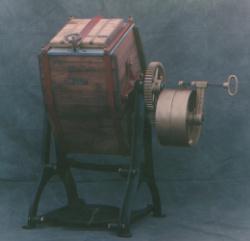 The Troy machine, Fig. 9,
was manufactured in Troy, New
York. The wooden tub of this machine rotates and the
clothes are tumbled as they wash. The single control positions the belt,
connected to the driving source of power, either to be on the drive (inner)
pulley or on the idler (outer) pulley. With about 250 pounds of gears and
pulleys as large as those for a tractor, the Troy
company made a machine which would certainly withstand much abuse. Can you
imagine children playing around this machine while it's operating?
The Troy machine, Fig. 9,
was manufactured in Troy, New
York. The wooden tub of this machine rotates and the
clothes are tumbled as they wash. The single control positions the belt,
connected to the driving source of power, either to be on the drive (inner)
pulley or on the idler (outer) pulley. With about 250 pounds of gears and
pulleys as large as those for a tractor, the Troy
company made a machine which would certainly withstand much abuse. Can you
imagine children playing around this machine while it's operating?
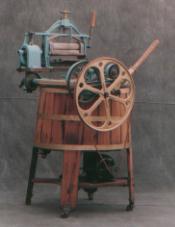 The Horton Company, of Fort
Wayne, Indiana,
produced the electric machine of Fig. 10. This machine features a
powered wringer which could be swung around its post to allow positioning over
external rinse tubs. The wringer also has a safety release. Being one of the
Horton company's first electric models there seemed to be less than total
confidence in electric power. Note the lever by which the machine can also be hand
operated. An advertising pamphlet attests to the importance of this machine. "A
Horton Washer will add many years to your life. It will save your health-- keep
the wrinkles out of your face--keep you youthful".
The Horton Company, of Fort
Wayne, Indiana,
produced the electric machine of Fig. 10. This machine features a
powered wringer which could be swung around its post to allow positioning over
external rinse tubs. The wringer also has a safety release. Being one of the
Horton company's first electric models there seemed to be less than total
confidence in electric power. Note the lever by which the machine can also be hand
operated. An advertising pamphlet attests to the importance of this machine. "A
Horton Washer will add many years to your life. It will save your health-- keep
the wrinkles out of your face--keep you youthful".
 The Daylight Company of Minneapolis
produced the majestic looking machine of Fig. 11. The agitator consists
of a single large cone nearly the diameter of the tub. By means of a thoroughly
complicated arrangement of gears, chains, pulleys and belts, the arms on either
side of the tub are made to pulsate up and down pushing and pulling the
agitator and causing huge tidal waves inside the tub. This machine would stand
a good chance of winning first place in a Rube Goldberg contest. At first use
of this machine, the ladies surely must have had wide and amazed eyes.
The Daylight Company of Minneapolis
produced the majestic looking machine of Fig. 11. The agitator consists
of a single large cone nearly the diameter of the tub. By means of a thoroughly
complicated arrangement of gears, chains, pulleys and belts, the arms on either
side of the tub are made to pulsate up and down pushing and pulling the
agitator and causing huge tidal waves inside the tub. This machine would stand
a good chance of winning first place in a Rube Goldberg contest. At first use
of this machine, the ladies surely must have had wide and amazed eyes.
Perhaps the most remarkable machine, for its time, was the Laun-Dry-Ette, Fig
12, made by the Home Specialty Company of Cleveland,
Ohio.  Note the absence of a wringer.
During the wash mode, by means of a simple mechanism, twin cups, comprising the
agitator, are pulled up and down and in addition, given a twisting motion. When
the wash is done the operator disengages the clutch (made of steel and leather)
and then pushes down on the foot pedal, thereby raising the basket, containing
the clothes, out of the water. By again engaging the clutch the basket is
caused to spin and the water is extracted from the clothes, reminiscent of the
automatic machines today. One of the models of this machine, in my collection,
has as its last patent date, December 26, 1905. Somewhat surprising, since spin
dry automatic machines were not in common usage until after World War II.
Note the absence of a wringer.
During the wash mode, by means of a simple mechanism, twin cups, comprising the
agitator, are pulled up and down and in addition, given a twisting motion. When
the wash is done the operator disengages the clutch (made of steel and leather)
and then pushes down on the foot pedal, thereby raising the basket, containing
the clothes, out of the water. By again engaging the clutch the basket is
caused to spin and the water is extracted from the clothes, reminiscent of the
automatic machines today. One of the models of this machine, in my collection,
has as its last patent date, December 26, 1905. Somewhat surprising, since spin
dry automatic machines were not in common usage until after World War II.
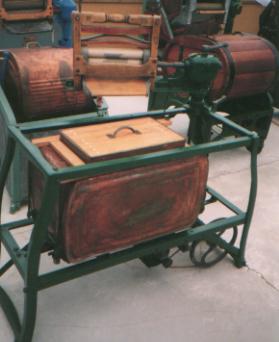 The Locomotive washer,(Brantford
Washing Machine Company, Brantford,
Canada) Fig.
13, realizes agitation by the sloshing action inside the tub as it is
pushed back and forth. The copper tub has three wheels on its bottom and acts
as a trolley rolling on the triple track system below it. Mounted below the tub
is a natural gas burner allowing the water to be heated in the tub. No pilot
light or automatic shut-off system was provided. Consequently if the flame were
to be blown out, sparks from the brushes on the electric motor might well
explode you and your happy home!
The Locomotive washer,(Brantford
Washing Machine Company, Brantford,
Canada) Fig.
13, realizes agitation by the sloshing action inside the tub as it is
pushed back and forth. The copper tub has three wheels on its bottom and acts
as a trolley rolling on the triple track system below it. Mounted below the tub
is a natural gas burner allowing the water to be heated in the tub. No pilot
light or automatic shut-off system was provided. Consequently if the flame were
to be blown out, sparks from the brushes on the electric motor might well
explode you and your happy home!
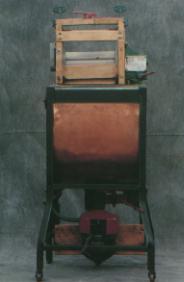 The Geyser of Fig. 14 has a very unique
system of agitation. The shaft of the motor, mounted directly beneath the tub,
extends into the tub and is connected to a steel propeller. Clothes are put
into a free-wheeling basket and are tumbled or otherwise jostled by the
turbulence created by the propeller turning at 1750 RPM! Although, in the
1920's, there were a large number of companies producing an even larger number
of different machines, only one firm, the Lovell Manufacturing Company, of Erie,
Pennsylvania made most of the
wringers for these machines. Sometimes the Lovell wringer is identified by the
name, Anchor Brand, along with the picture of an anchor. Apparently the
Lovell's safety release, patented May 15, 1915, proved to be a best seller. The
Geyser machine has on it a Lovell wringer common to a number of other machines
pictured herein. The American Wringer Company of New
York, sometimes under the name of Horse Shoe Brand,
also produced wringers for a number of different washing machine manufacturers.
The Geyser of Fig. 14 has a very unique
system of agitation. The shaft of the motor, mounted directly beneath the tub,
extends into the tub and is connected to a steel propeller. Clothes are put
into a free-wheeling basket and are tumbled or otherwise jostled by the
turbulence created by the propeller turning at 1750 RPM! Although, in the
1920's, there were a large number of companies producing an even larger number
of different machines, only one firm, the Lovell Manufacturing Company, of Erie,
Pennsylvania made most of the
wringers for these machines. Sometimes the Lovell wringer is identified by the
name, Anchor Brand, along with the picture of an anchor. Apparently the
Lovell's safety release, patented May 15, 1915, proved to be a best seller. The
Geyser machine has on it a Lovell wringer common to a number of other machines
pictured herein. The American Wringer Company of New
York, sometimes under the name of Horse Shoe Brand,
also produced wringers for a number of different washing machine manufacturers.
The present day Speed Queen company evolved from the Barlow and Seelig
Company, Ripon Wisconsin,
producers of the Big 3 washing machine of Fig. 15. Inverted cones were
used as agitators in each of the tubs. A rinse tub would ordinarily be located
on a stand behind each of twin wash tubs. The swinging wringer could then be
positioned to direct clothes into any of the tubs. Although the washer was
originally equipped with shields for the mechanisms on top of the lids, they
were probably soon removed by the owner so that lubrication was more
convenient. Also it became more convenient for fingers to be smashed. 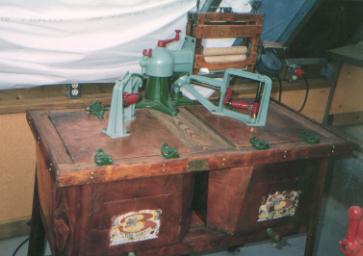
An agitator, which resembles inverted bread pans, is rocked back and forth
by the connecting levers on the Rightway Suction washer of Fig. 16. 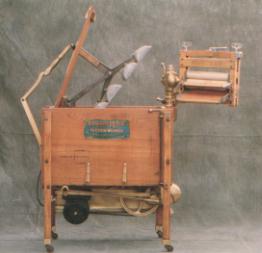
Produced by the American Gas Machine Company of Albert
Lea, Minnesota, this
machine has a rectangular shaped copper tub completely encased in a splendid
wooden box. The black lettering on the left side of the decal indicates water
levels for desired load sizes.
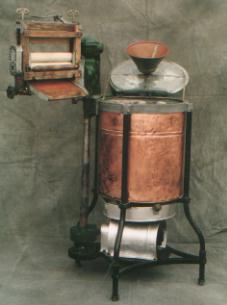 The Almetal
Manufacturing Company of St. Louis,
Missouri advertised the machine of
Fig. 17, for use as a fruit and vegetable canner as well as for a
washing machine. At the bottom of the copper tub is a natural gas burner which
allows the water to be brought to a boil right in the tub. The machine features
an "elevator" arrangement whereby the clothes are lifted out of the
water as the lid is opened. While used in the canning mode the inverted cone
agitator is removed and up to 32 quart jars may be put into the tub for
cold-pack processing. Advertising literature indicated, "if men had to do
the washing, every house would have an Almetal". It is believed that this
is the only model produced by this firm.
The Almetal
Manufacturing Company of St. Louis,
Missouri advertised the machine of
Fig. 17, for use as a fruit and vegetable canner as well as for a
washing machine. At the bottom of the copper tub is a natural gas burner which
allows the water to be brought to a boil right in the tub. The machine features
an "elevator" arrangement whereby the clothes are lifted out of the
water as the lid is opened. While used in the canning mode the inverted cone
agitator is removed and up to 32 quart jars may be put into the tub for
cold-pack processing. Advertising literature indicated, "if men had to do
the washing, every house would have an Almetal". It is believed that this
is the only model produced by this firm.
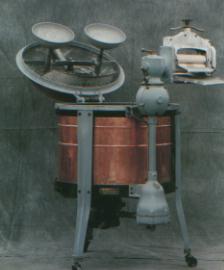 The Hart-Paar tractor company of
Charles City, Iowa made the unique washer of Fig. 18. To my knowledge,
this was the only model produced by the company and indeed it has some unusual
features. Two inverted cups, attached to the lid, alternately go up and down to
effect the agitation or washing action. While washing, the entire tub is
rotated by the 1/4 hp electric motor turning a large gear attached to the under
side of the tub. A gas burner under the tub allows the water to be heated
before, and during, the time washing is being done.
The Hart-Paar tractor company of
Charles City, Iowa made the unique washer of Fig. 18. To my knowledge,
this was the only model produced by the company and indeed it has some unusual
features. Two inverted cups, attached to the lid, alternately go up and down to
effect the agitation or washing action. While washing, the entire tub is
rotated by the 1/4 hp electric motor turning a large gear attached to the under
side of the tub. A gas burner under the tub allows the water to be heated
before, and during, the time washing is being done.
Most common of the pre 1935 washing machines is the gray square tub Maytag
and there are several Maytag models which look very similar to the one of Fig.
19. That is except for the butter churn and meat grinder optional
attachments shown in the photograph. Ordinarily the wringer would be in place
of the meat grinder and the agitator in place of the butter churn. Using the
same drive and clutch mechanism as for the wringer resulted in a very powerful
grinder which has forward and reverse capability.
Of all the washing machine manufacturers doing business in 1920, only two
are yet producing washing machines using the original company name, Maytag and
Dexter. Currently the Dexter company, of Fairfield,
Iowa, produces washing machines
used primarily by Laundromats.
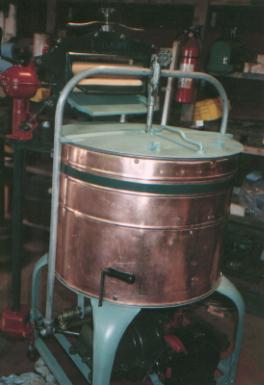 The wooden tub Dexter
shown in Fig. 20, has an on-board Briggs and Stratton gasoline engine.
The wooden tub Dexter
shown in Fig. 20, has an on-board Briggs and Stratton gasoline engine.
Like many machines of this era it came equipped with an attached folding
shelf on which the rinse tubs were put. Rot resistant woods like white cedar
and cypress were used to make many of the wooden tubs for machines like the
Dexter. When these woods become dry they shrink causing the tubs to leak. For
that reason the makers would put instructions to the effect that the tubs
should be soaked long and well before use....
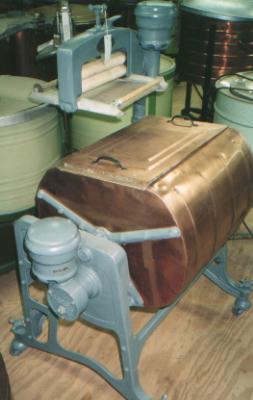 The
only venture into the washing machine market made by the Delco-Light Company of
Dayton, Ohio
is illustrated by the machine of Fig. 21. Two models of this machine
were produced, one for 32 volt DC power and the other for 110 volts. Even for a
rocker the Delco is unusual because it has one motor to power the rocking tub
and another to power the wringer. Rather than using mechanical means to achieve
the oscillatory motion of the tub, it is done electrically. The universal type
motor has 3 brushes and two of these are alternately lifted off the commutator
by a rod connected to a cam on the axle of the tub. Being offset from one
another, the alternate lifting of brushes causes the motor to reverse. Because
of this continued reversing of the motor, it is imagined that much electric
sparking resulted and brushes as well as commutators surely had to be repaired
often. I once corresponded with the Delco-Light Company but no one there seems
to remember the firm ever making such a machine.
The
only venture into the washing machine market made by the Delco-Light Company of
Dayton, Ohio
is illustrated by the machine of Fig. 21. Two models of this machine
were produced, one for 32 volt DC power and the other for 110 volts. Even for a
rocker the Delco is unusual because it has one motor to power the rocking tub
and another to power the wringer. Rather than using mechanical means to achieve
the oscillatory motion of the tub, it is done electrically. The universal type
motor has 3 brushes and two of these are alternately lifted off the commutator
by a rod connected to a cam on the axle of the tub. Being offset from one
another, the alternate lifting of brushes causes the motor to reverse. Because
of this continued reversing of the motor, it is imagined that much electric
sparking resulted and brushes as well as commutators surely had to be repaired
often. I once corresponded with the Delco-Light Company but no one there seems
to remember the firm ever making such a machine.
 Several
companies produced small, apartment sized washers most of which would not
accommodate anything like a pair of overalls. Three of these "
Dainties" washers are the Boyer-Schultz, the Hamilton
Beach and the Little Giant,
shown left to right in Fig. 22. The Boyer-Schultz machine is comprised
of a cast aluminum pot mounted on a motorized base. The action of this machine
resembles a hula dancer as the pot oscillates and goes up and down. Still in
business but not producing washing machines is the Hamilton Beach Company that
produced the portable machine which uses a quite ordinary copper boiler as the
tub. Bolted to the top of the lid is a small electric motor and gear housing.
Inside the tub are two inverted cones that are alternately driven up and down.
Although I have not seen them, Hamilton
Beach must have made other
small appliances to be used along with the motor, since it can be easily
removed from the washer and it has its own footed stand. The Little Giant
Washing Machine Company of Chicago
produced the small machine having the tilted tub. The action of this machine is
captivating, as it resembles an amusement park tilt-a-whirl. Made to wash only
"dainty" things it looks and sounds as if it would do a magnificent
job of washing.
Several
companies produced small, apartment sized washers most of which would not
accommodate anything like a pair of overalls. Three of these "
Dainties" washers are the Boyer-Schultz, the Hamilton
Beach and the Little Giant,
shown left to right in Fig. 22. The Boyer-Schultz machine is comprised
of a cast aluminum pot mounted on a motorized base. The action of this machine
resembles a hula dancer as the pot oscillates and goes up and down. Still in
business but not producing washing machines is the Hamilton Beach Company that
produced the portable machine which uses a quite ordinary copper boiler as the
tub. Bolted to the top of the lid is a small electric motor and gear housing.
Inside the tub are two inverted cones that are alternately driven up and down.
Although I have not seen them, Hamilton
Beach must have made other
small appliances to be used along with the motor, since it can be easily
removed from the washer and it has its own footed stand. The Little Giant
Washing Machine Company of Chicago
produced the small machine having the tilted tub. The action of this machine is
captivating, as it resembles an amusement park tilt-a-whirl. Made to wash only
"dainty" things it looks and sounds as if it would do a magnificent
job of washing.

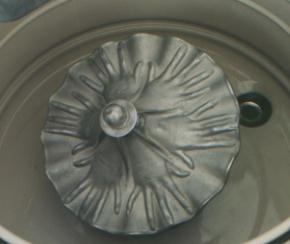 The Thor of Fig. 23a. has perhaps the
most artistic of agitators, Fig. 23b. Along with the hands, somewhat
reminiscent of Australian Aboriginal art work, is imprinted the phrase "hand
gentleness-machine speed". In operation the agitator wobbles around in
one direction for about 10 seconds, then automatically stops and then wobbles
back in the opposite direction. A gentleman ,who was a Thor salesman in the
1930's, told me that it was popular to paint the finger nails red while the
machine was on the dealer's showroom floor.
The Thor of Fig. 23a. has perhaps the
most artistic of agitators, Fig. 23b. Along with the hands, somewhat
reminiscent of Australian Aboriginal art work, is imprinted the phrase "hand
gentleness-machine speed". In operation the agitator wobbles around in
one direction for about 10 seconds, then automatically stops and then wobbles
back in the opposite direction. A gentleman ,who was a Thor salesman in the
1930's, told me that it was popular to paint the finger nails red while the
machine was on the dealer's showroom floor.
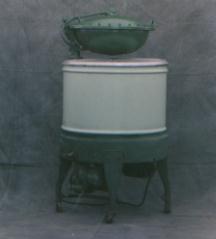 Perhaps the strangest of all is another Thor
machine shown in Fig. 24. Beneath this ordinary looking porcelain
washing machine is mounted a 4-cylinder air compressor driven by the same
electric motor that powers the agitator. Instead of using a wringer, the large
gadget resembling a giant clam extracts water from the clothes. The wet clothes
are put in the bottom half of the shell and then the lid is shut and sealed
like that of a pressure cooker. As air from the compressor is pumped into the
top of the clam shell, a large diaphragm literally presses the water out of the
clothes and lets it run down into the tub below. The gentleman, from whom I
purchased this wondrous thing, said that it was used also to extract juice from
grapes for making wine.
Perhaps the strangest of all is another Thor
machine shown in Fig. 24. Beneath this ordinary looking porcelain
washing machine is mounted a 4-cylinder air compressor driven by the same
electric motor that powers the agitator. Instead of using a wringer, the large
gadget resembling a giant clam extracts water from the clothes. The wet clothes
are put in the bottom half of the shell and then the lid is shut and sealed
like that of a pressure cooker. As air from the compressor is pumped into the
top of the clam shell, a large diaphragm literally presses the water out of the
clothes and lets it run down into the tub below. The gentleman, from whom I
purchased this wondrous thing, said that it was used also to extract juice from
grapes for making wine.
All of the machines pictured, with the exceptions of the "clam
shell" Thor and the Maytag with the meat grinder, have been revived.
I use the word revive, in lieu of restore, as these machines are not put back
to their exact original condition. Each washer was completely dismantled,
cleaned, sand blasted, repainted and reassembled. The condition of many
machines, as they are found, is, as the antique columnist put it, "little
more than junque". Many machines are either completely rusted, covered
with decades of hardened grease or have fallen apart to be in several pieces.
Of my 608 machines, I have only about a dozen which were found in "museum
quality" condition. When painting, original colors were often used on
metal parts whenever identification was possible. I do not usually, however,
repaint wooden tubs, but instead, refinish them with oil. All but 4 of my 460
revived machines are in working condition. The four are awaiting parts which
were either missing or broken beyond repair. It is unfortunate we do not yet
have video capability within this magazine,[coming soon!, Dave] so you could
more appreciate the inventiveness put into these truly magnificent and dynamic
works of art and technology.
Among the larger manufacturers producing powered washing machines prior to
1935 and which have not been mentioned above are: Altrorfer Bros. Co. (ABC),
Apex, Automatic, Barton, Birtman, Blackstone, Bluffton, Boss, Brammer,
Clarinda, Coffield, Conlon, Crystal, Easy (Syracuse Washing Machine Corp.),
Eden, Fairbanks-Morse, Federal, Frantz, Gainaday, Graybar, Grinnell, Haag,
Maxwells, Meadows, One Minute, Puffard-Hubbard, Savage, Voss, Westinghouse,
White Lily, Woodrow and Zenith (Hirschy).Most of the washer companies were
located in the midwest with Iowa, Illinois and Indiana hosting a majority of
the firms.
Some of these early washers would seem to have worked better than others.
Indeed some seem to have provided more frustration, or perhaps entertainment,
than good laundry service. Our government would not allow us to use a single
one of these now, lest we lose too many essential parts of our bodies. On the
other hand this magnificent parade may remind us how truly ingenious our
forebears were.
My appreciation to Ron Lutz for taking some of the photographs herein... L.
Maxwell
· Send
Comments to: 
 In Grandmother's estimation, if there was a
perfume called "scent of satisfaction, "its fragrance would be
that of a huge pile of just-finished laundry. Indeed it was satisfying to have
the chore of Mondays done, and to be able to sit down, have a cup
of tea and just relax for a bit. During her tenured term of doing laundry, from
about 1890 to 1950, Grandma had spanned the (Washing Machine) age, during which
a great majority of the innovation in laundry devices was made. Before the late
1800's there were relatively few factory-made laundry devices which had
multiple moving parts. Since 1950, few notable changes have occurred in the way
washing is done.
In Grandmother's estimation, if there was a
perfume called "scent of satisfaction, "its fragrance would be
that of a huge pile of just-finished laundry. Indeed it was satisfying to have
the chore of Mondays done, and to be able to sit down, have a cup
of tea and just relax for a bit. During her tenured term of doing laundry, from
about 1890 to 1950, Grandma had spanned the (Washing Machine) age, during which
a great majority of the innovation in laundry devices was made. Before the late
1800's there were relatively few factory-made laundry devices which had
multiple moving parts. Since 1950, few notable changes have occurred in the way
washing is done.



















![]()


